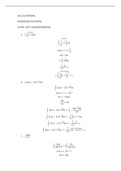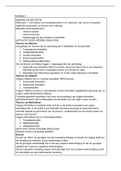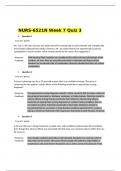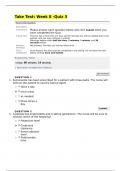Stella Hassan
Health and Social Care
Unit 12: Supporting Individuals with Additional Needs
P1 – Explain diagnostic procedures to determine additional needs for one child and one
adult with different additional needs.
1: Introduction
Additional needs might occur for a different number of reasons. One reason might be that
someone has a disability, this could result in them having problems with the way that they move
about for example, a physical disability.
Additional needs are needs that a child or adult may have on top of their ‘normal’ needs. It tends
to affect people who have a health and/or developmental condition. The terms mild, moderate,
severe and profound are commonly used when describing someone who has an additional need.
It can help determine their treatment plan and also make sure they receive the correct amount of
support to support them with their additional need and anything that may impact on them
because of it.
For example, an additional need that may impact someone’s life could be attention deficit
hyperactivity disorder or ADHD, also referred to commonly as ADD. Attention deficit
hyperactivity disorder can affect people’s lives in many ways.
A mild condition is where someone can perform tasks with little to no difficulty but may have
the odd problem with completing a task. They may be able to complete ‘normal’ day-to-day
activities – but struggle with specific ones.
A child who has a moderate learning disability might have problems with immaturity, and it may
seem like they are needy. Generally, students who have difficulty and have a moderate learning
disability that affects them have: problems acquiring logic, finding long instructions difficult,
poor auditory/visual memory, speech and language delay, poor fine and motor skills, emotional
and behavioural issues, problems acquiring basic skills in reading, writing and numeracy. This
results in a lack of confidence in using and developing the skills they have, they also have the
inability to generalise learning and apply it to new situations, they also learn much slower than
their peers. (The Good Schools Guide, 2015) People with a moderate learning disability have an
IQ of between 35-50. Someone who has a severe learning disability will have little to no speech,
find it very difficult to learn new skills, need support with daily activities – such as dressing,
washing, eating and keeping safe – as well as understanding when to perform these tasks,
however, they might be able to communicate using simple sentences or basic words. They will
also have difficulties with social skills and will likely need carers and require long-term support.
A profound learning disability, also known as PMLD, is when a person has a severe learning
disability as well as other disabilities that significantly affect their ability to communicate and be
independent. People with profound and multiple learning disabilities could have difficulty
seeing, hearing, speaking and moving. They also might have complicated health and social needs
due to these or other conditions. They could have learning difficulties, not to be confused with
learning disabilities, but may have autism or ADHD or a heart defect for example.
, Supporting Individuals with Additional Needs 2
2: introduce the case studies
Case study 1 is Rebecca Brown who is 8 years old and is in a wheelchair. She has tetraplegia.
Tetraplegia means that Rebecca has no ability to move the upper and lower parts of the body.
The areas of impaired mobility usually include the fingers, hands, feet and toes and she may be
unable to move her head also. This means that Rebecca would likely struggle with day-to-day
activities such as washing, completing personal care tasks such as brushing teeth and using the
bathroom independently. She has this condition due to her being involved in a car crash when
she was five years old, and Rebecca is now eight years old.
She has a brother, Michael, who is 12 years old. She also lives with her two parents who are
called Sue and David, David works long hours, working at a factory, where he works full-time,
earning a low wage. Her mum (Sue) works part-time in a day nursery but does have to stay home
during the school holidays which means that the family’s income is significantly reduced. They
live in an upstairs apartment, provided for them by a housing association – but it is small and not
‘wheelchair friendly, the neighbourhood where they live isn’t tolerant of her differences and
Rebecca has had to deal with some nasty comments about her condition as having her family,
this causes them to not want to go out, so they try and stay inside as often and as much as they
can. Rebecca attends a specialist school – one for children with additional and specific needs.
She receives support from two people; one of whom is a personal carer, who would help her in
school with personal care – e.g. using the bathroom. She also receives support from a designated
teaching assistant who may be able to help her if she needs academic or moral support for
example. They can also make sure that Rebecca feels safe and comfortable, and that no one is
bullying her while she is in school. Prior to her accident, Rebecca likely didn’t have any
additional needs but due to her condition and how profound the accident has affected her, this
means that she requires a lot of extra support for example, in school needing a personal care
assistant and a support assistant highlights that Rebecca has considerable needs – as a result of
the accident.
Ben is 52 years old and has Down’s Syndrome and type 2 diabetes. He has a learning age of 8
years old and requires support with all aspects of daily living. He lives in a group setting with
other adults who have learning difficulties and require additional support. Ben used to live with
his mother, but she died last year and therefore it looks like Ben doesn’t have any other family
who can look after him; which is likely why he got transferred to the residential setting. Ben used
to enjoy going shopping, but since moving into the residence, he prefers to stay in his room
which has become concerning for the staff. This is because there was an incident involving some
local youths who shouted at Ben when he went shopping with the residents and carers. He was
also denied entry from entering a local funfair by the manager of the funfair who said that Ben’s
appearance could prevent people from wanting to attend. Ben is also refusing to keep to a
particular diet that he has been asked to do, to protect his health. Staff have been finding bags of
sweets under his pillow whilst they are doing his bed. His blood glucose levels are unstable,
which are resulting in Ben feeling unwell. This means that he has become withdrawn, and this
could be due to him losing his mother, or due to the emotional effects of his diabetes being
uncontrolled, leading to his moods changing and emotions being quite overwhelming.
3: explain the diagnosis given for each case study
, Supporting Individuals with Additional Needs 3
Rebecca Brown has been diagnosed with tetraplegia; she is paralysed due to a traffic accident
when she was 5 years old. Tetraplegia is a term used to describe the inability to voluntarily move
the upper and lower parts of the body.2 This diagnosis has affected Rebecca in a variety of
ways. The first that Rebecca has been affected is by losing the ability to use her lower limbs.
This means that Rebecca might have problems with using the bathroom, and she will have to use
the help of her parents or a carer to do personal tasks like washing, which can cause
embarrassment, and she might feel like her dignity has been taken away from her. Rebecca is 8
years old and when the accident happened, she was 5, meaning she was probably about to
become independent and complete tasks like using the bathroom alone – however now she may
be unable to do that. Intellectually, Rebecca could have difficulties with her memory as a result
of problems after the car accident, like mental health issues that could have arisen, for example,
anxiety, as these can occur after a traumatic event like a traffic accident. Emotionally, Rebecca
may be affected the most. This is because, she might experience feelings of sadness that could
relate to her loss of independence and the loss of her doing things alone, like meeting with
friends for example. She could also have problems with her self-esteem, and she might feel a
range of emotions, which are likely to vary from depressive feelings to total frustration because
she cannot do sporting activities like she used to. Due to this, she might act out and get frustrated
at school or have problems getting along with her sibling and parents. There is a chance that
Rebecca could be starting adolescence – which could lead to more rage-fuelled arguments, and
mood swings about public life, but also about her being tetraplegic. This could further be
amplified through people making comments about her – highlighting that it is a ‘difference’ and
Rebecca might feel self-conscious and start to develop problems with self-image and could be
radical out of frustration and end up seriously injuring herself by trying to use her wheelchair as
little as possible, putting her health and wellbeing at a higher risk. Socially, she could become
isolated because other children may judge her, impacting her emotional development.
Tetraplegia (Klebine, 2010) and paralysis would have been diagnosed by a doctor, and Rebecca
would have been X-rayed and shown that her spinal cord is severely injured, at a point known as
the cervical spinal cord. The cervical spinal cord is where the neck is and connects the neck all
the way down the back and to the coccyx. In paraplegia, however, only the lower back area is
affected and so the individual may be able to hold cutlery or draw for example – but they will
likely be wheelchair bound since they are predominantly affected by the lower back region not
functioning correctly.
The diagnosis process would have involved a range of professionals and technical equipment.
The diagnosis process will have to find out why the individual has tetraplegia. Then exams and
tests will run, depending on the suspected cause. An X-ray and CT scan will be run, especially
since Rebecca’s cause was a car accident. An MRI is likely to also be helpful, as this can help
display a more accurate assessment of the spinal cord. A lumbar puncture can also help examine
the cerebrospinal fluid. Neurophysiological studies can help assess nerve damage and assess
nerve connectivity. Furthermore, conducting blood tests may also help doctors and professionals
find out how severe Rebecca’s tetraplegia is, and what their treatment plan for her should be,
making sure that they can tailor it to Rebecca’s condition. To get that, an appropriate amount of
tests will need to be conducted to properly tailor the plan to suit Rebecca’s needs, as needs can
be everchanging.
, Supporting Individuals with Additional Needs 4
Ben:
Type 2 diabetes:
Ben has been diagnosed with type 2 diabetes. Type 2 diabetes is a common condition that causes
the level of glucose in the blood to become too high. It can cause symptoms such as excessive
thirst, needing to urinate a lot, and tiredness. It is caused by problems with a hormone in the
body, known as insulin. Type 2 diabetes is also often linked with type 2 diabetes being present in
the family, overweight, or being inactive. The diagnosis for type 2 diabetes means that Ben will
have to monitor his blood sugar levels and should opt for healthier foods, as this will lower the
likelihood of him feeling unwell due to fluctuating blood sugar levels. Type 2 diabetes for Ben,
is usually diagnosed in adults and this is likely when Ben would have received his diagnosis. It
could be argued that due to his Down’s Syndrome, Ben is at more of a risk of developing type 2
diabetes, as Down’s Syndrome comes with a higher risk of developing diabetes type 2. Type 2
diabetes is detected through a urine test or through a blood test. For type 2 diabetes, medicines or
lifestyle/dietary changes or a combination of these can help control type 2 diabetes. A rigid
dietary plan could help symptoms and further help Ben. Another example could be the
medication ‘metformin’ prescribed for type 2 diabetes to help control blood sugar levels, or if
you are at risk of prediabetes – you could be referred to a dietician by a doctor for advice on
dietary changes or an individual may be encouraged to take up exercise.
Down’s Syndrome
Down’s Syndrome is usually diagnosed in infancy. Furthermore, the diagnosis for Down’s
Syndrome can be quite complicated. Between 10 and 24 weeks when the baby is still in the
womb, there will be a screening test for Down’s Syndrome that women are offered. If there is a
higher chance from the original screening tests that a child will have Down’s Syndrome, they
will be offered more tests. If a baby is diagnosed with Down’s Syndrome, they might need help
with specific tasks like feeding – but will need the same as any other baby – comfort, love and
support.
Intellectually, Down’s Syndrome can affect someone’s processing speeds and they may need
extra support in their school subjects or in their everyday life, and subsequently, they may
require a team of carers. Additionally, individuals with Down’s Syndrome will have a degree of
learning disability, meaning they will have a range of abilities. People with Downs’ Syndrome
could be slower at learning skills, and also have impacted social development, namely through
speech development delays and could need support from a professional such as a speech and
language therapist. Physically people with Down’s Syndrome can have different facial features
than other people, which sometimes ends up in the individual being bullied or teased due to their
appearance as it is not ‘typical’. Individuals with Down’s Syndrome are at a higher likelihood of
developing hearing, digestive, and sight difficulties – so having an educational, health and care
plan can help an individual with Downs’ Syndrome gain access to support in their education and
training for example.










